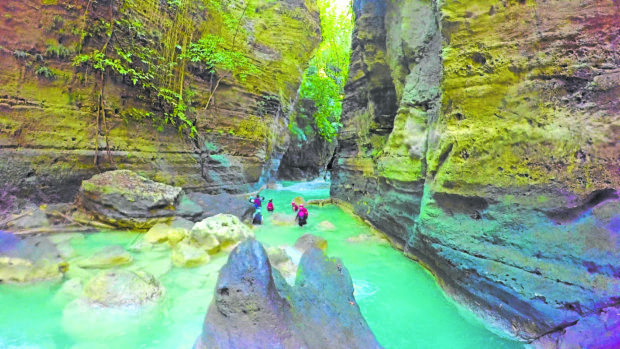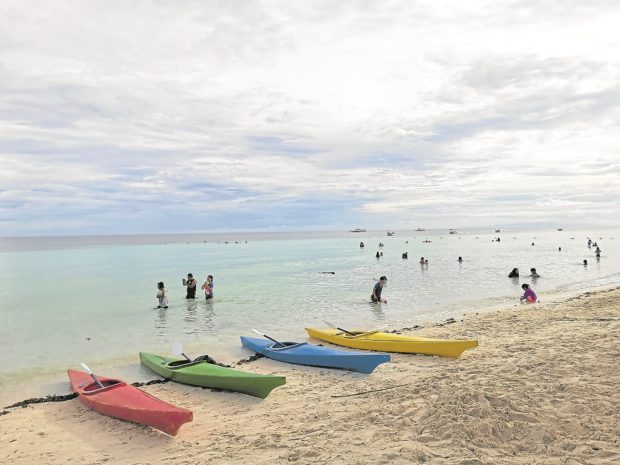Pandemic batters Visayas tourism

WIND AND WATER FUN In this photo taken on March 7, several tourists and locals enjoy kitesurfing and other water activities on Boracay Island in Malay, Aklan. Although still far from prepandemic numbers, visitor arrivals in Boracay are increasing despite travel and health restrictions. —JACK JARILLA
(First of two parts)
ILOILO CITY, Iloilo, Philippines — Mahid Bani has not yet resumed selling pearls on the resort island of Boracay in Aklan province despite the increasing tourist arrivals since it reopened in June last year after more than two months of lockdown due to the COVID-19 pandemic.
“Some vendors selling souvenirs have reopened shops but sales are not enough for overhead expenses, including the space rental fees even if these have been lowered to half the rate,” he said.
Tourists in Boracay, he said, spend most of their time in restaurants and hotels, not in souvenir shops.
“Reopening shops is like a gamble because we are not sure whether or not there will be enough tourists to sustain us,” he said.
Article continues after this advertisementIn Bohol province, some cafés and restaurants on Alona Beach at Barangay Tawala, Panglao Island, were still closed.
Article continues after this advertisementThe business center in Alona was so quiet that cats slept on tables of shuttered cafés.
Some establishments attempted to open but only to close down after a few days due to low sales and high operating cost, especially with the need to strictly comply with health protocols.
“No one is coming. A few locals come occasionally,” said a café owner.
In Cebu province, Mika Oyamada was enjoying the beach of a five-star resort on Mactan Island one Friday afternoon, with only a handful of guests.
“It’s like a private beach now,” she told the Inquirer, noting the contrast from the prepandemic period when it was teeming with guests.
Struggle
“My daughter and I felt lonely. We couldn’t hear any sound at the lobby and the garden. Yes, we sometimes miss the festive atmosphere like before the pandemic,” said Oyamada, a Japanese who lives in Cebu.
A year after tourist arrivals plummeted due to the pandemic, businesses in Boracay, Cebu and Bohol still struggle to remain afloat even if they have reopened to visitors late last year.
Health concerns and travel restrictions have put the tourism industry in the Visayas continuously on the edge.
Those who can afford to travel have to bear with strict travel protocols, including the presentation of negative reverse transcription-polymerase chain reaction (RT-PCR) test results.
The local market cannot also sustain the operation of their tourism destinations because many are also struggling financially since many have either lost their jobs or don’t have regular working schedules due to cost-cutting measures imposed by companies to remain afloat.
“We’re surviving but it’s very, very difficult,” Wesley Van Der Voort, president of the Philippine Chamber of Commerce and Industry Boracay, one of the island’s business groups, told the Inquirer.
Van Der Voort said many businesses in Boracay had closed but some had reopened and were trying to sustain their operations with a lean workforce.

CEBU ADVENTURE Thrill seekers, in this undated photo, head to Badian in southern Cebu province for canyoneering, which put the town on the must-visit list of outdoor enthusiasts. The Cebu provincial government has reopened local attractions in an effort to revive the economy. —PHOTO COURTESY OF CEBU PROVINCIAL TOURISM OFFICE
Low occupancy
He said there were not enough guests to fill hotels and other accommodation establishments on the island due to continued apprehension on traveling among tourists.
In Cebu, many resorts are operating at a loss due to low occupancy.
Alfred Reyes, president of Hotel, Resort and Restaurant Association of Cebu Inc., said these properties continued to operate even at 25-percent capacity in order to protect their equipment and facilities which would be damaged should they shut down completely.
“Rehabilitation will cost you more,” he said.
While waiting for the market to improve, Reyes said the owners would have to dip in their pockets in order to continue operating.
Asked how long they can continue doing that, he replied: “It depends how deep their pockets are.”
But it is not just the resorts and the hotels that are bleeding but people in communities who rely on tourists to bring food on the table.
Some boat operators offering island-hopping to tourists have either turned to fishing for their sustenance or have sold their boats to have cash.
Maria Lester Ybañez, Cebu provincial tourism officer, told a story of a displaced boatman whose family would eat only sweet potato and salt when tourism activities had stopped.
One tour guide had told provincial officials that they could no longer remember what money looked like because they had not seen a bill for a long time, she added.
“Our main economic driver is tourism,” she said.
When this was affected, she said those who suffered the most were small businesses, like pumpboat operators, tour guides and tricycle drivers, among others, who relied on tourists for their next meal.
Before the global health crisis hit the Philippines in March 2020, 6.8 million tourists visited Cebu province in 2019, bringing in at least P104 billion in revenues.
At least 2.03 million tourists visited Boracay in 2019, generating P58.18 billion. Bohol hosted 1.5 million foreign and domestic tourists in the same year, with Chinese visitors leading the arrivals, followed by Koreans, records from the Bohol Tourism Office showed.
These tourists disappeared when provinces started closing their borders as strict quarantine guidelines had to be followed in March 2020 in a bid to control the spread of COVID-19.
Boracay Island lost at least P49 billion in potential revenues in 2020 when tourist arrivals plunged by 83.56 percent to 334,455 and revenues dropped to P9.18 billion.
Bohol Gov. Arthur Yap said the province lost at least P15 billion in revenues and P308 million in room accommodation daily on Panglao Island alone when the province was placed on stricter community quarantine for eight months.
Aside from establishments in Panglao, also affected were resorts and other tourism establishments in Jagna and Anda towns popular for their pristine beaches and dive sites.

WEEKEND DESTINATION The beach on Panglao Island is among the favorite weekend destinations of local tourists in Bohol province, like these visitors who took a dip in its calm waters on Feb. 7. —LEO UDTOHAN
Job losses
The pandemic affected some 200,000 tourism industry workers in Bohol, with about 40 percent of them losing their jobs.
Many establishments retrenched workers, just like in Cebu and Boracay. Others were given two or three days to work if the resort had guests staying for longer periods.
Some tourism workers who lost their jobs shifted to fishing but this created another problem.
Ybañez said since these people were not fishermen, some corals were damaged in the process while endangered fish species were not spared. Others, she added, resorted to dynamite fishing.
Those who didn’t go into fishing turned to vegetable farming.
But most survived on “ayuda,” or financial and food aid from government agencies, although these were not enough to sustain their families.